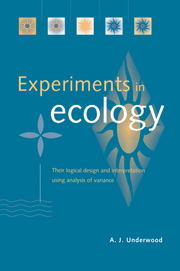Book contents
- Frontmatter
- Contents
- Acknowledgements
- 1 Introduction
- 2 A framework for investigating biological patterns and processes
- 3 Populations, frequency distributions and samples
- 4 Statistical tests of null hypotheses
- 5 Statistical tests on samples
- 6 Simple experiments comparing the means of two populations
- 7 Analysis of variance
- 8 More analysis of variance
- 9 Nested analyses of variance
- 10 Factorial experiments
- 11 Construction of any analysis from general principles
- 12 Some common and some particular experimental designs
- 13 Analyses involving relationships among variables
- 14 Conclusions: where to from here?
- References
- Author index
- Subject index
3 - Populations, frequency distributions and samples
Published online by Cambridge University Press: 05 June 2012
- Frontmatter
- Contents
- Acknowledgements
- 1 Introduction
- 2 A framework for investigating biological patterns and processes
- 3 Populations, frequency distributions and samples
- 4 Statistical tests of null hypotheses
- 5 Statistical tests on samples
- 6 Simple experiments comparing the means of two populations
- 7 Analysis of variance
- 8 More analysis of variance
- 9 Nested analyses of variance
- 10 Factorial experiments
- 11 Construction of any analysis from general principles
- 12 Some common and some particular experimental designs
- 13 Analyses involving relationships among variables
- 14 Conclusions: where to from here?
- References
- Author index
- Subject index
Summary
Introduction
The preceding account of a logical framework for investigating biological observations is not as easy to use as might be hoped. The major problem is that neither the original observations nor the results of tests are unambiguous. Biological observations (in whatever form the data are collected) are not constant, fixed truths, but vary from place to place and from time to time. So, of course, do measurements in other sciences, such as chemistry and physics. Even where intrinsic variability is small or absent (i.e. the measurement is of some physical or chemical constant), both the machinery used to make measurements and the observers themselves are not constant.
Variability in measurements
There are intrinsic and extrinsic reasons why biological observations are variable. Intrinsic reasons include, first, fundamental properties of biological systems. For example, the size of an animal, the rate of growth of a plant, the speed of movement of a predator are all subject to genetic variability from one individual to another. Thus, unless the individuals are identical in all genetically determined processes of growth or speed (respectively), there is no possibility that their sizes (or speeds) will be identical.
Second, in addition to innate properties of systems, there are intrinsic processes causing variability. For example, the diameters of oocytes in a gonad are influenced by stresses, pressures, rates of cellular division, position in the gonad, etc.
- Type
- Chapter
- Information
- Experiments in EcologyTheir Logical Design and Interpretation Using Analysis of Variance, pp. 24 - 49Publisher: Cambridge University PressPrint publication year: 1996



